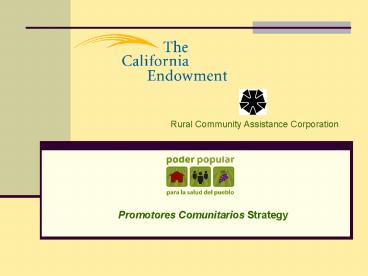Promotores Comunitarios Strategy - PowerPoint PPT Presentation
1 / 32
Title:
Promotores Comunitarios Strategy
Description:
The Promotores Comunitarios Strategy envisions communities ... South Kern County. East Coachella Valley. North San Diego County. Monterey County. Tulare County ... – PowerPoint PPT presentation
Number of Views:35
Avg rating:3.0/5.0
Title: Promotores Comunitarios Strategy
1
Rural Community Assistance Corporation
- Promotores Comunitarios Strategy
2
Vision
- The Promotores Comunitarios Strategy envisions
communities in which agricultural workers and
their families are actively engaged, mobilized,
and empowered
3
The Regions
- Napa Valley and Sonoma Creek Area
- Merced Area
- Westside of Fresno County
- Oxnard Plain
- South Kern County
- East Coachella Valley
- North San Diego County
- Monterey County
- Tulare County
4
Poder Popular para la Salud del PuebloA
place-based approach for improving health
The Program is rooted in the fundamental belief
that to achieve lasting improvements in the
health and well-being of agricultural workers, it
is essential to improve environmental influences
in the places where they reside.
It is based on the notion that every community
has assets and resources, that when more
strategically aligned around community-driven
priorities can lead to more effective change.
5
Three Impact Areas
Population Health
Systems Change
Community Health
6
The Promotores Comunitarios Model
- Involves a process to empower residents to
improve their overall quality of life
7
The Model Phase I Overview
- Capacity Building
- Empowerment model vs. traditional health
promotion model - Utilize popular education methods
- Recruit Promotores
- Train Promotores
- Individual Skills
- Community Skills
8
The Model Phase I Overview (cont.)
- Capacity Building
- Community outreach
- Baseline Asset Mapping
9
The Model Phase II Overview
- Organized for Action
- Health Priorities Identification
- Engaging farm workers through Community Forums
and Events - Análisis de la Situación
- Discuss issues
- Prioritize issues
- Understand and select top issue
- Identify root cause
10
The Model Phase III Overview
- Socio-Political Action
- Formalization of Comités del Pueblo
- Support Comités
- Leadership building
- Action planning
11
Using Popular Education Methods
- To make a complex process more understanding we
created a map to be used as a board game.
12
The Model Phase I Capacity Building
Training
2
1
Strengthening Individual Skills
3
Recruit leaders to become Promotores Comunitarios
Support the development of leaders, agents of
change, advocates
I do not know my community and its resources
4
Learn about neighborhoods and areas Learn
demographics
5
Identify 5 health assets
Baseline Mapping
13
The Model Phase I - Implementation
- Recruitment of Promotores
- Development distribution of
- flyers begins at
- Health fairs
- Job fairs
- School meetings
- Migrant meetings
- Church meetings
- flyers posted throughout
- community.
14
The Model Phase I - Implementation
- Strengthening Individual Skills
- Orientation/ Welcoming Meeting
- Overview of Promotores Comunitarios Model
- Self-Esteem/ Positive self talk
- Community Leadership
- Communication skills
- Presentation skills Part 1
15
The Model Phase I - Implementation
- Support the Development of Agents of change.
- Presentation Skills Part 2
- Community Organizing Principles
- Baseline Asset Mapping
- Mapping the community
16
The Model Phase I - Implementation
- Graduation/Recognition Ceremony for Promotores
17
The Model Phase II Organized for Action
6
What are the health priorities?
7/8
8/7
What people are interested about/feel affected
by?
There is not community base
- Forums
- Festivals
- Charlas
- Home meetings, etc.
9
Base Building
Análisis de la Situación What, why, who, when,
etc.?
10
Understand issues affecting us
11
Identify short, mid and long term priorities
Foster Critical Thinking
No Critical thinking
18
The Model Phase II Implementation
- Promotores identify what residents consider the
top health priorities
19
The Model Phase II Implementation (cont.)
- Promotores as Leaders and Agents of Change
- They chose the dates/times for the community
forums - Conduct outreach to invite residents and delegate
responsibilities - Co-facilitate the events
20
The Model Phase II Implementation (cont.)
- Promotores organized community events and forums.
21
The Model Phase II Implementation (cont.)
- During Forums the top 5 community health issues
are discussed and prioritized to select focus
22
The Model Phase II Implementation (cont.)
- Promotores Comunitarios discuss root causes as
well as how these health issues effect the
overall community.
23
The Model Phase II Implementation (cont.)
- The Presentation of Árbol Social (Social Tree)
was one of the most engaging activities.
24
The Model Phase II Implementation (cont.)
- Promotores facilitate discussions to identify
short, mid term and long term issues.
25
The Model Phase III Socio-Political Action
Go back to Phase II
12
13
Select the issue in which efforts will be focused
Strategic Planning (Asset Mapping follow up)
14
Identify groups leadership
15
Identify groups leadership
16
Formalize Comités del Pueblo
No collective action
Changes, Improvements, Impact!!!!
26
The Model Phase III Implementation
- Promotores facilitate discussions to identify
issue
27
The Model Phase III Implementation (cont.)
- Strategic planning begins
Who is Affected
Issue
Action
28
The Model Phase III Implementation (cont.)
- Promotores facilitate meetings to identify assets
to support efforts
29
The Model Phase III Implementation (cont.)
- Next Steps
- Engage and Mobilize Community Residents
- Develop Structure and Protocols for the Comité
del Pueblo - Formalize Comites del Pueblo
- Involve and Gain Support from Local Community
Groups and ECVSCC
30
The Model Phase II Implementation (cont.)
- Formalize Comités del Pueblo
- Comités will Develop Action Plans to Address the
Top 2 Priority Health Concerns - Comités will Implement Action Plans by Engaging
in Community Organizing Strategies and Advocating
at a Local Level
31
Empowering Grassroots Leaders
32
Promotores en Acción

